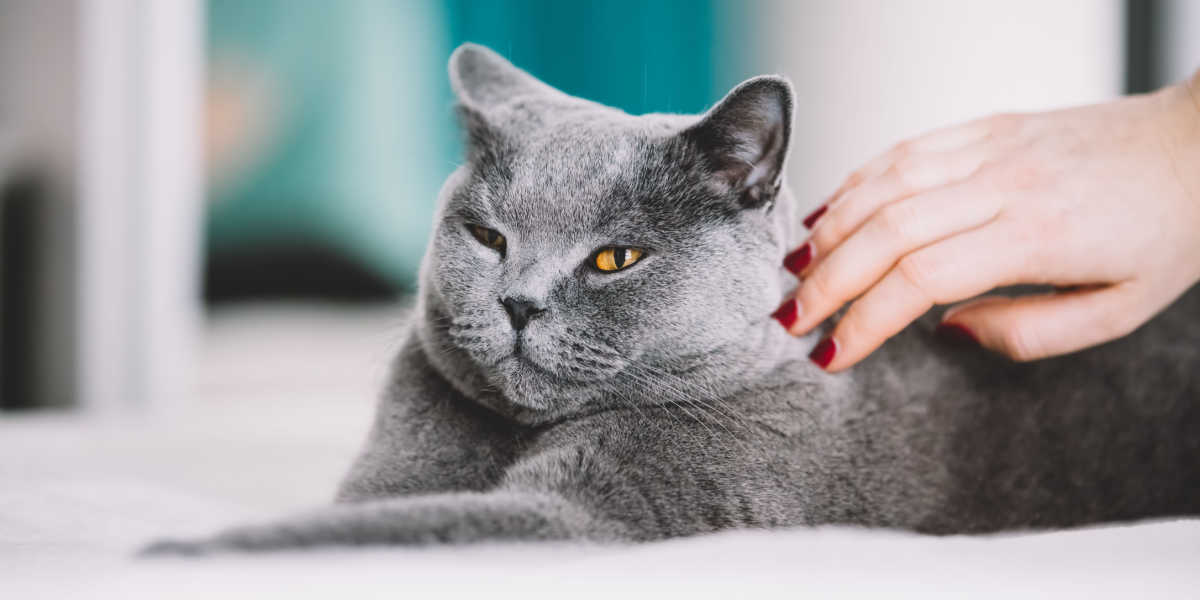
Humans bundle up in extra warm layers when the temperature drops. But do cats get cold? They only have their permanent fur coat to keep them warm in freezing weather. Do we need to worry about our outdoor cats if they feel cold to the touch, or will they manage?
Feeling your cat's fur with your hand is not an accurate way of assessing body temperature. If your cat’s fur feels cool but they have no symptoms and are behaving normally, it’s unlikely there is anything wrong. If your cat is lethargic, in pain, or showing other symptoms of being unwell, or has cold extremities, get them checked by a veterinarian as soon as possible.Key Takeaways
There’s a difference between feeling chilly and having hypothermia—when you get so cold that your body temperature drops below the normal range. Let’s find out how, as a cat owner, you can tell the difference between life-threatening body temperature changes and normal temperature fluctuation in your cat.
Also Read: Cat Body Temperature: Causes & Treatment of Abnormal Body Temperature
Why Might Your Cat Feel Cold to the Touch?
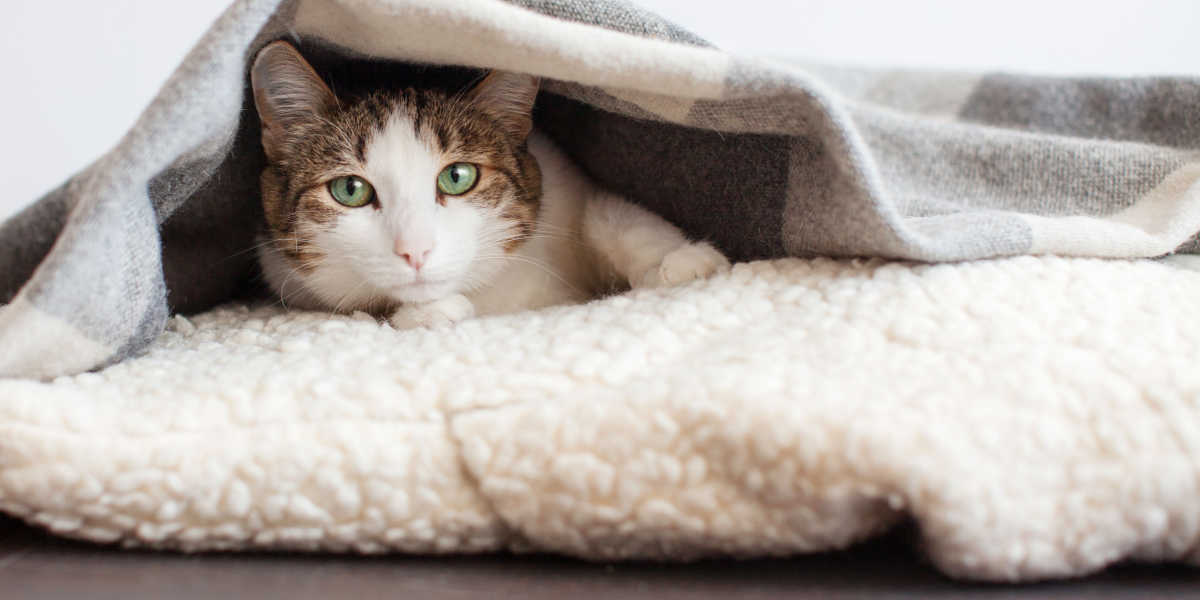
When cats begin to feel cold, they instinctively search for places to warm themselves up.
There are lots of reasons why your cat might feel cooler to the touch than you’d expect, and it doesn’t necessarily mean anything serious. Although we might have been told by our parents when we were young, “You need a coat, you don’t want to catch a cold,” it’s unlikely that cold temperatures will actually give your pet a cat cold.
Here are some of the incidental, environmental reasons why you might notice that your cat feels cold when you pet them.
1. They’ve Been Outside

For cats that have just been outside, it can be normal for their fur to feel cold, even if their body is warm.
If it’s cold weather outside in the winter months and your feline family member has just run in through the cat flap to greet you (or place their order for breakfast!) and you notice their fur feels cold when you pet them, it’s probably just because they’ve been outside.
A cat’s fur is perfect for the job of keeping their body heat in to keep them warm when it’s cold Their coat can also keep them cool when it’s hot. Give your cat 10 minutes or so to warm up before you panic. The next time you touch them, you’ll likely notice that they feel toasty warm.
Of course, in extremely cold temperatures your cat might be at risk of hypothermia or even frostbite. To learn more about hypothermia, read our article How Cold Is Too Cold For Cats?
2. They’ve Been in the Shade
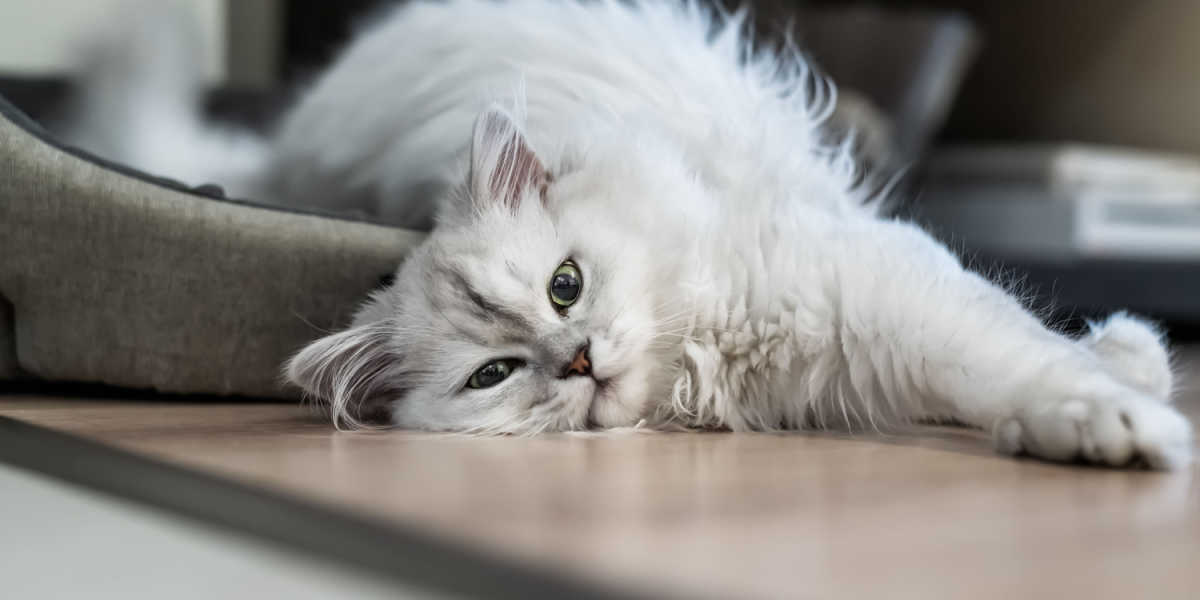
If your cat has been lying in a shady spot to cool down, their fur might feel cold to the touch.
Cats are clever when it comes to regulating their body temperature—it’s their instinct. On a warm, sunny day, cats might spend some time sunbathing in the spot where the sun shines through the window or on the patio.
However, when they start to feel a little too warm, they’ll head off in terms of a shady spot. So, if your cat’s been cooling off in the shade before you go to give them a cuddle, it’s not surprising if their fur feels cool, especially if you’re warm from enjoying the sun.
Also Read: Why Do Cats Love To Sunbathe?
3. They’ve Been Lying on a Cool Surface
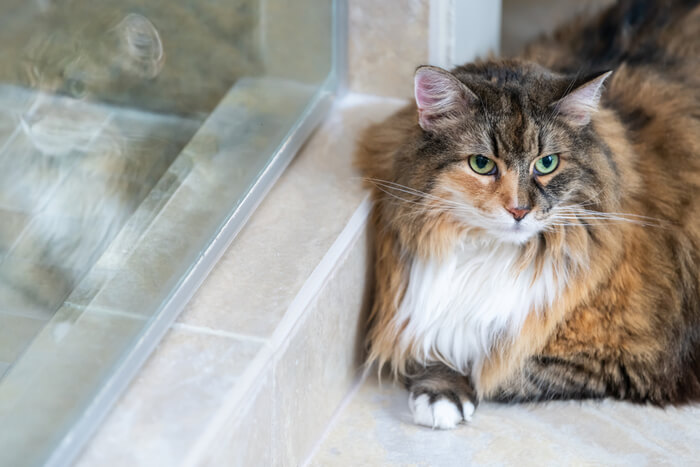
Lying on tile or concrete can temporarily make a cat feel cold to the touch.
Many cats will sleep anywhere but their cat bed! If your indoor cat’s been sprawled out on your glass coffee table (no judgment here!) or lying on your stone or marble floor, their fur’s bound to feel cool in the areas that have been in contact with the cool surface. Check their fur in other places before you start to worry that something’s wrong.
Also Read: Why Do Cats Lie On Uncomfortable Things?
4. They’re Wet
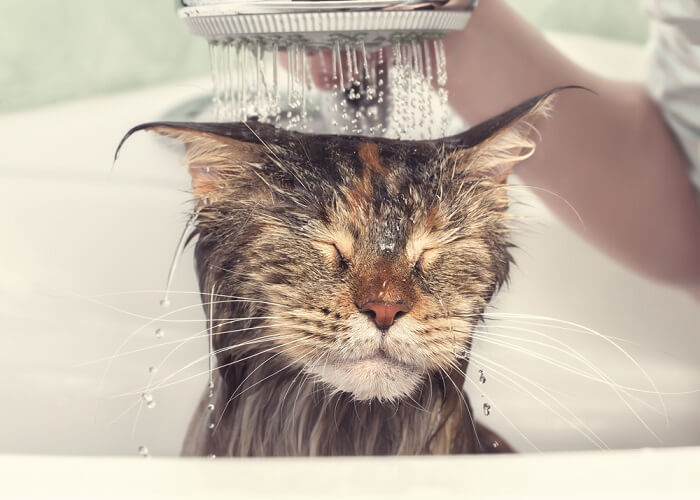
Be sure to dry your cat well after a bath so they don’t remain damp and become cold.
It might seem obvious, but your cat might feel cold to the touch if they’re wet. However, that’s not always the case, and many cats will start to feel warm when they’re wet, as their body’s temperature regulation mechanisms start to warm them up.
If your cat is wet and feels cold, try drying them off and taking them somewhere warm. If their behavior still isn’t right or they don’t seem like their normal self, it’s best to contact the veterinary clinic for advice.
Also Read: How To Bathe A Cat (A Step By Step Guide)
5. Your Hands Are Warm

If your hands are warmer than usual, it’s possible for your cat to feel cold to the touch.
There’s no substitute for using a thermometer when it comes to measuring temperature. Using your hands to check how warm or cool your cat feels is very subjective. A cat’s normal body temperature is between 97.7 and 102.2 degrees Fahrenheit (36.5 and 39.0 degrees Celsius), but If your hands are cold, your cat might feel particularly warm.
Equally, if your hands are warm, your cat might feel cold. The typical place to take your cat’s temperature is the rectum with plenty of lubricant, so it’s best left to the professionals.
Also Read: Why Does My Cat Feel Hot To Touch? When To Worry
What Medical Reasons Could Cause Your Cat To Feel Cold to the Touch?
Sometimes, there are more concerning reasons why your cat might be cold. Let’s find out some of the possible causes of low body temperature in cats.
1. Trauma and Pain
If your cat gets injured, loses a lot of blood, is in pain, or goes through any traumatic ordeal, they might develop shock. This is where the body’s circulatory system sends all the blood to the brain and vital organs, leaving the extremities with minimal blood flow and feeling cold.
If this is the underlying reason for your cat feeling cold to the touch, you might find evidence like scuffed claws, wounds, or bleeding, and your cat might have a limp or another obvious injury. In this scenario, it’s really important to get your cat to the veterinary clinic as soon as possible, for pain relief, warming, and a fluid drip.
Also Read: 10 Ways To Tell If Your Cat Is In Pain
2. Poor Circulation
Heart failure and other cardiovascular issues can also cause shock due to poor circulation. If your cat has heart failure you might notice symptoms like difficulty breathing, a prominent belly, pale or blueish gums, or even collapse.
A blood clot could also cause a lack of blood supply to one or more of your cat’s limbs, causing that leg to feel cold. If you think your cat might have symptoms of a blood clot (thromboembolism) or heart failure, contact your veterinarian without delay.
Also Read: What To Do If Your Cat Is Sneezing Blood
3. Dehydration
If your cat is severely dehydrated, the amount of blood circulating around their body will decrease, and their blood pressure will drop, leading to shock. You can check whether your cat is dehydrated by picking up the skin on the scruff of their neck and releasing it. If it springs straight back to its original position then their hydration is good. If it lingers where you’ve lifted it and takes a while to return, they’re dehydrated.
Another easy test is to touch your cat’s gums. If the gums feel moist to the touch, the cat is well hydrated, but if the gums feel tacky or dry, they’re dehydrated. Dehydration can be very serious, so it’s important to contact your vet urgently if you think that your cat could be affected.
Also Read: What Can Cats Drink Besides Water?
4. True Hypothermia
Of course, it’s possible that a cat’s body temperature can drop without an underlying health condition or injury. If your cat gets stuck somewhere very cold or wet and is unable to move for a long period, they could end up with severe hypothermia.
If your cat is hypothermic, their heart rate will slow down and they’ll have shallow breathing. They’re unlikely to be able to stand or sit up, and they might not be very responsive. It’s essential in this situation that you call the vet and begin warming them with pet-safe heat sources that won’t leak (like a hot water bottle could) or cause burns. Blankets and covered wheat bags are the safest options.
Also Read: Why Is My Cat Shaking & Shivering? (And How To Help)
When Should You Worry About Your Cat Feeling Cold?
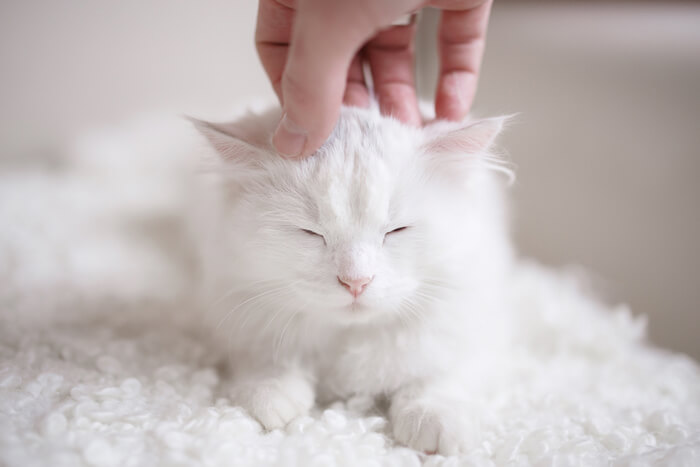
If your cat feels cold and also isn’t behaving normally, they need to be seen by a veterinarian.
There are a few tell-tale signs that can help you decide whether your cat’s coolness is something to worry about or not. Here’s a checklist of what you should look for:
1. Check Their Behavior
If your cat is eating, drinking, moving, and acting normally, and if they’re passing normal urine and feces, it’s unlikely that there’s anything serious going on that’s making them feel cold. However, if they’re very lethargic or unable to move, or they’re not eating or drinking anything at all, this could be an indication that they have a medical condition and need to see the vet urgently.
2. Look For Other Symptoms
If your cat has had diarrhea, vomiting, trouble breathing, seizures, or extreme lethargy, or if they have visible wounds or bleeding, they could be cold because they are unwell, and they need urgent veterinary attention. On the other hand, if your cat’s health has been generally good and they have no symptoms, it’s unlikely that there’s anything wrong.
3. Determine Where They Feel Cold
It can be normal for a cat’s ears and nose to feel a bit cold, and if they’ve been in contact with something cold or wet, these areas of their bodies might be cool to the touch. However, if one paw or leg feels cold compared to the others, or if all of their extremities feel cold, it’s time to take them to the veterinary clinic without delay.
Also Read: What Do Outdoor Cats Like To Sleep In?
What Should You Do if Your Cat Feels Cold to the Touch?
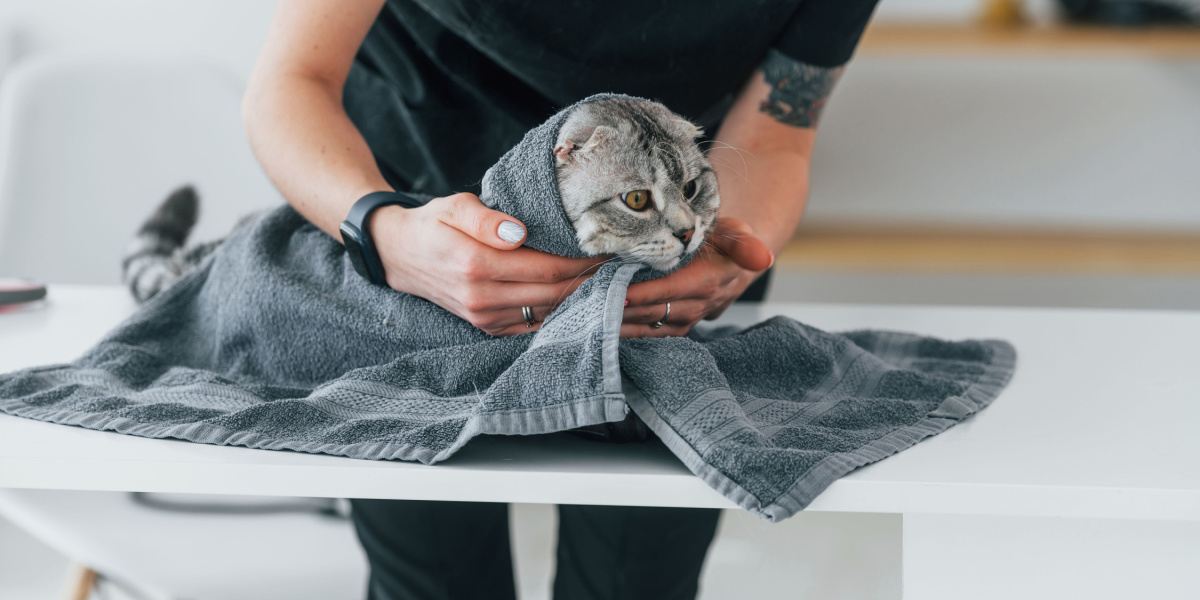
Use warm towels to dry off a wet cat, and bring them somewhere warm.
If your cat is cold and wet, it’s important to dry them quickly with a towel to help get your cat warm. You should also take them inside to a warm and cozy part of the house, near a radiator.
If, once they’re dry and curled up somewhere snug, they feel warm and are acting like their normal selves, there’s no need to worry. However, if they’re acting unwell or lethargic, you must seek veterinary advice and keep them warm during the journey to the clinic with pet-safe heating pads, blankets, or covered wheat bags.
Final Thoughts
As a pet parent, you might worry about your cat feeling the cold, but a cat’s fur will help to keep them well insulated most of the time. It’s unusual for a cat to feel cold, but if you notice any of the signs and symptoms above, it’s a good idea to get them to the veterinary clinic as soon as possible.
Also Read: The 5 Best Outdoor Cat Houses
Frequently Asked Questions
Why does my cat’s body feel cold?
If your cat’s fur feels cold but their skin feels warm, you can rest assured that they’re feeling warm enough. After all, their core body temperature is higher than what you can feel on the outside. However, if their skin feels cool to the touch, it could be a sign of shock, hypothermia, or a blood clot.
Should I be worried about my cat’s cold?
Despite the name, cats don't get respiratory illnesses from getting too cold. If your cat has cat flu, it's likely to be viral, but if they're off their food or acting very unwell you should contact your veterinarian.
Should a cat feel warm to the touch?
Cats should generally feel warm or have a similar temperature to us. Their fur might feel cold to the touch, but the skin (and the rest of your cat's body) underneath will be well insulated.







